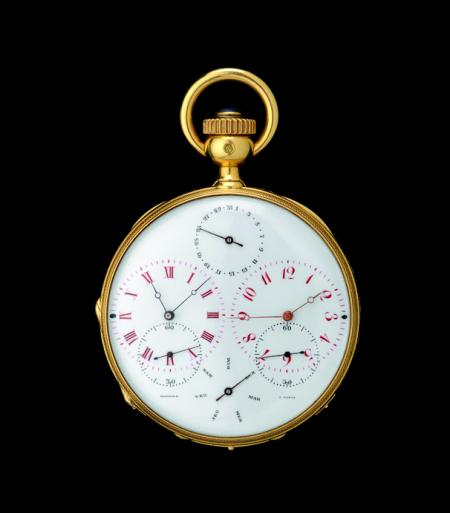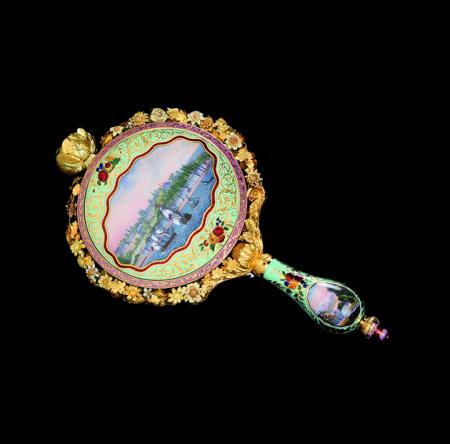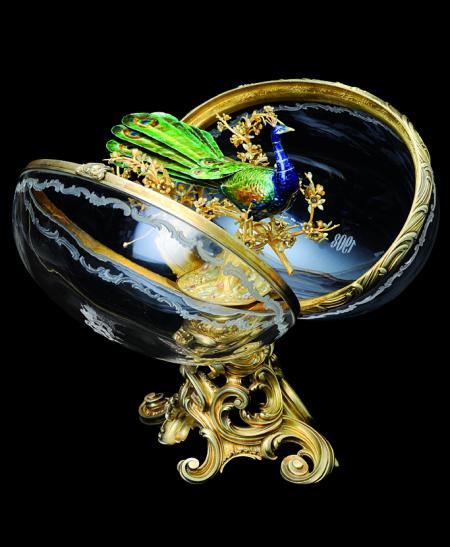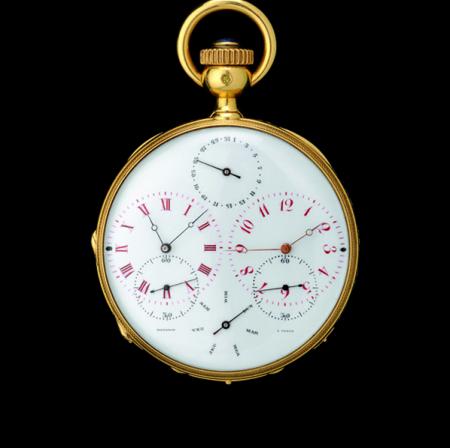Parmigiani Fleurier presents the exhibition devoted to the Sandoz collection in the gallery A La Vieille Russie in New York
By MyWatch
A La Vieille Russieand Parmigiani are excited to announce an exceptional event aimed at collectors and connoisseurs of watches, automatons, and Faberge, as well as all lovers of beautiful and rare objects. The Maurice Sandoz collection of ?fty pieces will be exhibited in New York at A La Vieille Russiefrom October 26th– November 26th, o?ering a unique opportunity to celebrate watchmaking art. It features mechanical marvels of the past, works of Fabergé including the Imperial Peacock and Swan eggs, and contemporary creations of Parmigiani Fleurier. The Haute Horlogerie brand, also renowned for its excellence in restoration, will exhibit its ?nest mechanical creations, which exemplify centuries of know-how.
For over 160 years, A La Vieille Russiehas forged a highly regarded reputation through its outstanding expertise in antique jewelry, porcelain, silver, and Fabergé automatons and masterpieces. Notwithstanding this extensive list, the renowned gallery is also distinguished in Russian art history. From its establishment in Kiev in 1851, then to Paris in 1920, and now in New York City since 1941, A La Vieille Russiehas been a cultural junction, where great collectors of world art, the press, royalty and nobility –Queen Maria of Romania, the Duke and Duchess of Windsor and King Farouk of Egypt –have convened. These prestigious customers and the enduring family management of Messrs, Paul, Peter and Mark Schaffer, have woven close ties over time. As such, A La Vieille Russiehas succeeded in keeping the legacy of Russian culture alive.
Maurice Sandoz, a writer, composer and enthusiast of timepieces and automatons, had an eye for exceptional pieces. Upon his arrival in the United States in 1941, Sandoz began to cultivate a close relationship with A La Vieille Russie. Through this relationship, Sandoz acquired in 1954 the celebrated Imperial Swan Egg, created by the jeweler Peter Carl Fabergé. The Edouard and Maurice Sandoz Foundation Collection now consists of several pieces by the legendary Russian jeweler, including the Miniature Piano, The Fabergé Imperial Peacock Egg, the Youssoupoff Egg, the Golden Peacock, and of course, the Imperial Swan Egg.
This fall the Maurice Sandoz collection will be displayed at A La Vieille Russiein honor of the gallery’s brilliant expertise. The breathtaking Fabergé pieces, along with other exceptional specimens of watchmaking art, will be gathered from the Edouard and Maurice Sandoz Foundation (FEMS) and the Watchmaking Museum at Château des Monts in Le Locle (MHL) for audiences at A La Vieille Russie. Pocket watches, the famous perfume spray gun, cages with songbirds, snuffboxes, and automaton clocks and animals are among the masterpieces that will be on exhibit.
Parmigiani Fleurier, renowned as one of the most prestigious contemporary Haute Horlogerie brands, demonstrates the genuine, extraordinary passion of its master watchmakers through the craftsmanship of each and every Parmigiani piece. Parmigiani’s restoration workshop houses treasures undergoing restoration or conservation, which are in high demand by the world’s great museums. Michel Parmigiani, the restorer of the Maurice Sandoz collection, remains the keeper of this knowledge. His commitment to a centuries-old tradition of excellent watchmaking manifests itself in the creation of contemporary, exclusive mechanical pieces. Such pieces will be exhibited for the first time at A La Vieille Russie. While each and every piece within the Sandoz collection boasts a variety of unique features, Parmigiani chose to recreate one of the piece’s mechanisms in tribute to the event –a timepiece with telescopic hands that run around the circumference of an oval-shaped dial –a nod to the inventiveness of the master watchmakers of the past.
DECISIVE ENCOUNTERS
Over the past thirty years, restoration has been a genuine passion of Parmigiani. Parmigiani views this enduring passion as a constant dialogue between the excellence of the past and the quest to use its expressions in watchmaking of the future. Restoration is above all a sequence of key encounters – with the genius of the masters of yesteryear and with exceptional private collectors possessing an undiminished passion for timeless watchmaking gems.
At the end of the Seventies, Ephrem Jobin, the first curator of Château des Monts, as well as other major collectors from Basel, would put their faith in Michel Parmigiani’s talent for restoration, entrusting him with great pieces early in his career. Conscientious of history’s consequence, Michel Parmigiani fashioned his own methodology which sets him apart: a constant balance between the mechanical functionality of the piece and conserving the know-how of the past. Michel’s work ethic would prove rewarding, as at the end of Ephrem Jobin’s career, Jobin entrusted Parmigiani to continue maintenance work on the Maurice-Yves Sandoz collection. This provided Michel Parmigiani with an extraordinary opportunity to come into contact with treasures of priceless historic value and to meet Pierre Landolt, Chairman of the Sandoz Family Foundation. From the Eighties onwards, Pierre’s trust would mark the beginnings of an exceptional watchmaking adventure, with the creation of the Parmigiani brand in 1996.
THE ETHICS OF PARMIGIANI. A DESIRE TO CONFRONT HISTORY
A restoration workshop dedicated to historical masterpieces is a unique concept in the very heart of a contemporary haute horlogeriemanufacture. This underlines the extent to which the demand for excellence shapes the day-to-day work of the Parmigiani Fleurier watchmakers.
THE INVESTIgATION PHASE
Mechanical objects born of the genius of past masters must be restored in keeping with the original methods. An essential introduction to understanding the masterpiece requires a long research phase before even touching the piece. With unique objects, the restorer has to trawl through works and museums to track down any related pieces that might give an indication as to the mechanism’s workings; or even play the role of the great Sherlock Holmes, detecting some traces or imprints left by the movement of a wheel that is no longer there. Hence before dismantling the piece, the restorer spends plenty of time stripping it down mentally…
IMMERSINg THEMSELVES IN THE PAST
The expert craftsmen must immerse themselves in the know-how and skills of the past in order to understand them, and to achieve a faithful reproduction. To this end, they must have perfect mastery of the knowledge of related branches, such as goldsmithing, enameling, chisel engraving, gilding methods or glass working.
CONSERVATION
Depending on a piece’s state of conservation, a long time may be spent patiently cleaning it. A highly destructive oxidation process often prevents the movement from working properly, leading to a meticulous task of rust removal and polishing. The “Perrin Frères” signed watch is one example of how a timepiece can suffer at the hands of time – the bells, posts, mobile stars, pinions, springs and index adjuster all had to undergo complete rust removal treatment.
Michel Parmigiani most recently conserved the exceptional Fabergé Peacock Egg – a highly attentive and delicate restoration job has now enabled the automaton to work harmoniously once more; the peacock moves on its two legs and fans out its tail feathers as it goes round. Retouching of its enamel, deliberately visible, also brought back a forgotten shine.
RECONSTRUCTION
The worst ravages of time are often nothing in comparison to the damage caused by an inexpert hand. When reconstructing, it is essential for Parmigiani to backtrack correctly instead of modifying the original. A complete written and photographic dossier retraces all the steps, always differentiating the reconstructed parts from others.
The Youssoupoff Egg, an enameled clock with a rotating ring made in the workshops of Carl Fabergé, is yet an example. Several broken components that were still present in its mechanism signed “Hy Moser &Co” were able to be perfectly rebuilt by the restorer, thanks to skilled measurements and highly technical computer diagrams. The winding pinion, winding ratchet and barrel arbor had to be reproduced.



